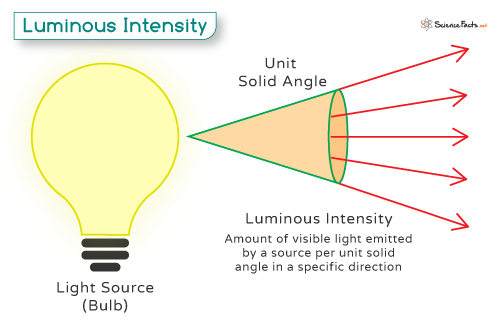Luminous Intensity
Luminous intensity refers to the quantity of visible light that a source emits per unit solid angle in a specific direction. It is a fundamental concept in photometry and helps gauge the brightness perceived by an observer from a particular source.
In simpler terms, luminous intensity measures how bright a light appears to the human eye in a particular direction. This quantity is essential for technical and scientific purposes. It significantly impacts our daily lives, influencing how we perceive and interact with our environment.
Formula
The formula for luminous intensity (Iv) is defined using the concept of radiant intensity (Ie) and the luminous efficacy (Km) of the emitted light. Radiant intensity measures the power emitted by a light source in all directions, while luminous efficacy relates this radiant power to the sensitivity of the human eye across different wavelengths. The formula is expressed as:
Iv = Ie x Km
The luminous efficacy adjusts the radiant intensity to reflect how the human eye perceives light, giving us a measure of brightness aligned with human perception.
Unit
The candela (cd) is the standard unit for measuring luminous intensity. If a light source emits green light at a frequency of 540 THz and has a radiant intensity of 1/683 watts per steradian in a particular direction, it will have a luminous intensity of one candela in that direction.
This unit provides a standardized measure for comparing the perceived brightness of different light sources, ensuring consistency in quantifying luminous intensity across various applications and industries. Through precise calibration and measurement techniques, candela offers a reliable metric for evaluating and designing lighting systems.
Relationship with Other Photometric Quantities
Luminous intensity is interconnected with other photometric quantities, forming the foundation of photometry:
Luminous Flux (Lumens): Luminous flux measures the total amount of visible light emitted by a source, irrespective of direction. It represents the overall brightness of a source. It is related to luminous intensity but considers the emission in all directions.
Illuminance (Lux): Illuminance measures the amount of light that falls on a surface area. It depends on luminous intensity and distance from the source, defining how bright an area appears rather than how much light a source emits.
Devices Used for Measuring Luminous Intensity
- Photometer: It measures the total luminous flux from a light source. By knowing the luminous flux and the geometry of the light distribution, luminous intensity can be calculated.
- Goniophotometer: This device measures the light emitted from an object at different angles. It combines a photometer and a goniometric motion stage. This comprehensive angular data helps directly determine the luminous intensity distribution.
- Spectroradiometer: It measures the spectral power distribution of a light source. With appropriate calibration and integration over the visible spectrum, it can provide luminous intensity measurements.
Applications
Luminous intensity finds extensive application across a spectrum of industries and everyday scenarios, where the quality and quantity of light significantly impact functionality, safety, aesthetics, and human perception.
- Home and Outdoors: It creates environments that are not only visually appealing but also functional. Whether architectural lighting for buildings, interior illumination for homes, or landscape lighting for outdoor spaces, understanding luminous intensity helps architects and designers achieve desired lighting effects.
- Automotive Industry: Precise control over luminous intensity ensures that vehicle headlights provide optimal illumination for safe driving conditions. Engineers calibrate luminous intensity from low to high beam settings to ensure visibility at different speeds and weather conditions, enhancing road safety for drivers and pedestrians alike.
- Aerospace and Navigational Systems: It dictates the effectiveness of aviation lights, navigation beacons, and signaling devices. These systems rely on specific luminous intensities to ensure aircraft visibility, aid navigation, and signal important locations or hazards, contributing significantly to aviation safety and operational efficiency.
-
References
Article was last reviewed on Friday, June 7, 2024








